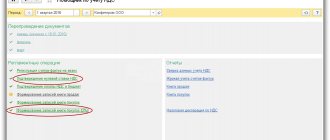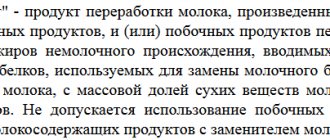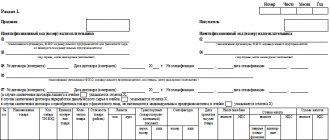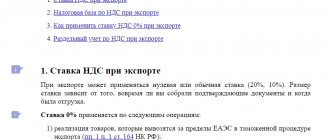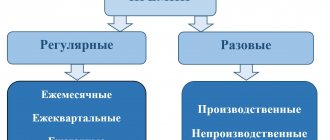The role of value added tax in the Russian Federation
Value added tax is an indirect tax of federal significance and plays a significant role in the formation of the budget of the Russian Federation. The value added tax is regulated by Chapter 21 Part 2 of the Tax Code of the Russian Federation.
The role of VAT in the state is quite high. Currently, the entire tax amount goes to the Federal Budget, which makes it possible to solve such important government tasks as:
- repayment of public debt;
- increasing pension and social benefits to citizens of the Russian Federation;
- implementation of a number of federal social programs, etc.
Algorithm of actions when calculating VAT
In order to accurately calculate VAT, you need to determine the following criteria:
| Criteria | Explanation |
| Determine tax rate | In accordance with Article 164 of the Tax Code of the Russian Federation, the following tax rates have been adopted:
|
| Determine the tax base | Initial cost of production + excise taxes |
| Calculate VAT using a specific formula | Formulas are presented in the section “Rate, formulas used for calculation” of this article |
In reality, there is nothing difficult in calculating VAT. It is enough to have specific ideas about the tax rate and tax base.
In what cases is VAT 10% from January 1, 2020
There are several rates for value added tax in Russia. In 2021, their value is 0%, 10% and 20% (clauses 1-3 of Article 164 of the Tax Code of the Russian Federation). The difference between them is due to:
- linking to certain types of activities, most of which involve crossing Russian borders - for a 0% rate;
- providing preferential tax conditions for a number of goods and some services - at a rate of 10%.
A rate of 20% should be used in all other situations, if they do not require the use of a calculated rate (derivative of 10% or 20%), at which the tax is calculated from the amount that includes its value (clause 4 of Article 164 of the Tax Code of the Russian Federation).
In what cases does 10 percent VAT apply? As of 01/01/2020, VAT 10% applies (clause 2 of article 164):
- to a number of food products, including: live cattle and poultry;
- meat obtained from them and products made using this meat (except for delicacies);
- products arising during the life of livestock and poultry (milk, eggs) and products created on their basis;
- vegetable oil, with the exception of palm oil, which is subject to VAT at a rate of 20% from 10/01/2019 (law dated 08/02/2019 No. 268-FZ);
- margarine and special purpose fats;
- sugar and salt;
- bread, cereals, flour, pasta;
- live fish and seafood (except delicacies) and products made from them;
- products made for children and diabetics;
- vegetables, including potatoes;
- from 10/01/2019 - fruits and berries, including grapes (law dated 08/02/2019 No. 268-FZ);
There are some nuances in applying the 10% rate to fruits and berries. Read about them in the Review from ConsultantPlus. Trial access to the system can be obtained for free.
- goods intended for children: knitwear;
- garments for sewing production (except for products made of genuine leather and natural fur, with the exception of sheepskin and rabbit);
- shoes (except sports shoes);
- beds, mattresses, strollers, diapers;
- toys and plasticine;
- stationery intended for training and development;
ConsultantPlus experts spoke in detail about how VAT is assessed on the sale of medical equipment and medicines. Get trial access to the system for free and go to the Ready-made solution.
- transportation carried out by air within Russia (except for those taxed at a rate of 0%).
By type (in relation to the codes of these types), the goods listed in this list are specified in the decrees of the Government of the Russian Federation:
- dated December 31, 2004 No. 908 - in relation to food products and goods for children;
- dated September 15, 2008 No. 688 - on medical goods;
- dated January 23, 2003 No. 41 - in relation to printed materials.
Therefore, to find an answer to the question: “What goods are subject to VAT of 10 percent in 2021?” — you should refer not only to the current edition of the Tax Code of the Russian Federation, but also to the current editions of these resolutions, keeping in mind that the text of the first of the documents (Resolution No. 908) was updated twice during the year.
Rate, formulas used for calculation
In accordance with Article 163 of the Tax Code of the Russian Federation, the VAT tax rate will depend on the economic activity carried out by the organization:
| VAT rate | Economic activity |
| 0% | Sales within the customs zone, export of products, international transportation. |
| 10% | Sale of children's products, medical supplies, some food products, printed publications, breeding animals and birds. |
| 18% | All business activities not mentioned above. |
It is very important to correctly determine the tax rate in order to avoid problems with the tax authorities.
Entrepreneurs have to deal with two cases of VAT calculation:
- it is necessary to determine VAT on the cost of goods, works, services;
- it is necessary to allocate VAT from the existing total amount.
If VAT is required on the cost of goods, works, services, the following formulas are used:
- VAT 18%:
| VAT | = | total amount | * | 0,18 |
- VAT 10%:
| VAT | = | total amount | * | 0,10 |
For example:
ABV LLC sells products to individual entrepreneur M.M. Mokhov. in the amount of 70,000 rubles. VAT 18%. The VAT amount will be 70,000 * 0.18 = 12,600 rubles. The amount to be paid will be 70,000 + 12,600 = 82,600 rubles.
Total:
The cost of production is 70,000 rubles. VAT 18% – 12,600 rubles. Payable – 82,600 rubles.
If it is necessary to isolate VAT from an existing total amount, the following formulas are recommended for use:
- allocation of VAT 18%:
| VAT | = | total amount | / | 118 | * | 18 |
- allocation of VAT 10%:
| VAT | = | total amount | / | 110 | * | 10 |
- 0% VAT is not allocated.
For example:
ABC LLC sells fishing nets at a price of 600 rubles per piece. including VAT 18%. IP Mokhov M.M. ordered 25 pcs. First you need to determine the total amount: 600 * 25 = 15,000 rubles. VAT will be: 15,000 / 118 * 18 = 2,288 rubles. Amount without VAT: 15,000 – 2,288 = 12,712 rubles.
Total:
The amount excluding VAT is 12,712 rubles. VAT 18% – 2288 rubles. The total amount to be paid is 15,000 rubles.
Manual VAT calculation
Manual tax calculation formulas are not so simple, especially if you are not accustomed to constantly using equations. That is why counters that help calculate the amount of VAT online or without taking it into account are so in demand. The use of such calculation forms does not require special skills; it is enough to enter certain amounts in the appropriate fields. But if you want to understand the algorithm by which you can calculate the tax percentage in order to check electronic calculations at any time, then you should turn directly to the formulas.
Manual calculation
The VAT amount is calculated using the formula:
VAT=X*20/100, where “X” is the actual cost of the product or service.
The amount including VAT is calculated as follows:
Xn = X+X*20/100 or Xn=X*(1+20/100)=X*1.20, where “X” is the cost of the product or is the amount including tax.
To calculate the amount excluding VAT, you should refer to the previous formula, entering into it an unknown that denotes the tax itself, for example “Y”. Taking into account that VAT is 20 percent, it is concluded that Y = 20/100. In this case, the calculation formula will look like this:
Xn = X+Y*X or Xn = X*(1+Y)
Continuing the calculations, we can get that X = Xn/(1+Y) = Xn/(1+0.20) = Xn/1.20.
Ultimately, everyone decides for themselves how to allocate VAT from the amount - using a formula or online.
What do you need to know to calculate VAT?
To calculate VAT, entrepreneurs need to decide on the indicators used to carry out this calculation:
| Index | A comment |
| The tax base | The tax base for calculating VAT will be considered (Article 153 of the Tax Code of the Russian Federation): · the volume of proceeds received from the sale of goods, services, works, property rights; · the amount of proceeds received under the agency agreement; · volume of funds received from the sale of imported goods, etc. |
| Tax rate | The tax rate is determined by Article 164 of the Tax Code of the Russian Federation and can be equal to 0%, 10%, 18%. |
Do you need an invoice?
This document is needed to confirm the right to deduct VAT. The buyer, a VAT payer, needs to issue an invoice, since it is this document that gives the buyer the right to apply a VAT deduction.
At the same time, you need to understand that the issuance of an invoice in itself does not confirm the fact of the transfer of goods or services: for confirmation, either an act of acceptance and transfer of work (property rights, services) or a delivery note is used. As for the invoice itself, the tax and accounting codes do not recognize it as a primary document.
How to determine the appropriate rate?
To determine the tax rate, you must be guided by Article 164 of the Tax Code of the Russian Federation:
| Tax rate | Type of economic activity |
| 0% | · export of goods; · international transportation of goods; · work related to pipeline transport of oil and petroleum products; · organization of pipeline transportation of natural gas; · export of electricity; · transshipment and storage of export goods in sea and river ports; · services for processing goods in customs zones; · goods, works, services in the field of space activities; · rail transportation of passengers and luggage on commuter and long-distance trains; · extraction of precious metals from scrap and waste; · goods, works, services for foreign diplomats. |
| 10% | · sales of food products; · sales of children's goods; · sales of printed products; · sale of medical products; · domestic air transportation. |
| 18% | All other cases not mentioned earlier. |
As is already clear, the tax rate depends on the type of economic activity. There are situations when an organization can simultaneously perform several operations related to different tax rates. In this case, it is necessary to make calculations very carefully using VAT calculation formulas.
How to calculate VAT on the amount?
There are situations when payment documents and contracts do not contain the VAT amount:
- advance payment against future delivery of goods;
- carrying out tax calculations by a tax agent;
- VAT is included in the price of the goods, but is not allocated.
In these cases, it is necessary to allocate VAT using the following formula (depending on the tax rate):
- allocation of VAT 18%:
| VAT | = | total amount | / | 118 | * | 18 |
- allocation of VAT 10%:
| VAT | = | total amount | / | 110 | * | 10 |
How to confirm the VAT rate of 10%
If an entrepreneur is going to switch to a reduced rate, then he needs to:
- First, familiarize yourself with the full list of products that are suitable for this;
- if the product is included in the list, then it must be registered, especially if we are talking about medicines;
- after which you need to collect a complete package of documents and submit it to the tax service.
Only after a complete check and verification of the necessary codes, the tax office will allow a reduced rate.
You must understand that all goods cannot be sold at a VAT rate of 10%. Before applying it, you need to carefully read Article 164 of the Tax Code of the Russian Federation. Then further work will not be particularly difficult.
How to calculate VAT for a quarter/half year/year?
The tax period for paying VAT is a quarter (Article 163 of the Tax Code of the Russian Federation). The declaration must be submitted to the tax authorities within the following deadlines:
| Quarter | Deadline for submitting the declaration |
| 1st quarter | Until April 25 |
| 2nd quarter | Until July 25 |
| 3rd quarter | Until October 25 |
| 4th quarter | Until January 25 |
VAT is paid in equal installments before the 20th day of each month of the next quarter:
| Quarter | VAT payment deadlines |
| 1st quarter | Until April 25, until May 25, until June 25 |
| 2nd quarter | Until July 25, until August 25, until September 25 |
| 3rd quarter | Until October 25, until November 25, until December 25 |
| 4th quarter | Until January 25, until February 25, until March 25 |
To correctly calculate VAT for the quarter, you must:
- Determine the tax base - the sum of all income received by the taxpayer during the tax period (Article 153 of the Tax Code of the Russian Federation):
| The tax base | = | Income received from sales | + | Advances |
- After determining the tax base, it is necessary to calculate VAT:
| VAT | = | The tax base | * | 0,18 (0,10) |
If an organization was engaged in the sale of goods, works, or services subject to different VAT tax rates, it is necessary to make calculations separately for each category. Read also the article: → “Procedure and deadline for paying VAT”
- After calculating VAT, it is necessary to make a tax deduction (Article 171 of the Tax Code of the Russian Federation).
A deduction is the amount of VAT that an organization has already paid to suppliers of goods, works, and services.
- Calculate VAT payable to the budget:
| VAT payable to the budget | = | VAT | – | Deduction |
In order for the entrepreneur to be able to confirm the accuracy of the information, it is necessary to fill out the following documents:
- invoice;
- Sales book;
- Book of purchases.
In the event of an inspection by tax authorities, this documentation must be provided to the inspectors. Organizations are required to make such VAT calculations quarterly. The law does not prohibit the transfer of deductions to subsequent quarters within three years, but the calculated VAT must be paid within strictly defined periods.
Issuing an invoice
In accordance with the Tax Code of the Russian Federation, paragraph 3, article 168, when selling goods (services, works), the VAT taxpayer is obliged to issue an invoice to the buyer no later than five from the date of shipment of the goods.
There are a few things to consider when issuing invoices. For example, in the case of continuous supply of products, transportation of gas, oil, electricity to the same buyers, in the provision of banking services, telecommunication services, in the daily sale of perishable food products to one buyer, invoices are allowed to be drawn up in accordance with the terms of the supply agreement. In the above cases, it is possible to issue invoices simultaneously with payment documents, but no later than the fifth day of the month following the end of the month, and at least once a month.
How to calculate VAT correctly?
Example:
LLC "ABV" for the 1st quarter of 2021 sold:
- chairs for the consulate 600 rub./piece. - 100 pieces.;
- buckwheat 50 rub./kg. – 200 kg;
- pasta 40 rub./kg. – 300 kg;
- children's beds 2000 rub./pcs. – 25 pcs.;
- building blocks 800 rub./m3 – 100 m3;
- cement 50 rub./mesh. – 100 mesh.
For the 1st quarter, the amount of VAT paid to suppliers amounted to 16,150 rubles.
It is necessary to determine the tax base:
VAT 0%: chairs for the consulate 600 * 100 = 60,000 rubles. VAT 10%: buckwheat, pasta, children's beds (50 * 200) + (40 * 300) + (2000 * 25) = 72,000 rubles. VAT 18%: building blocks, cement (800 * 100) + (50 * 100) = 85,000 rubles.
After determining the tax base, it is necessary to calculate VAT:
(72000 * 0.10) + (85000 * 0.18) = 22500 rubles. The amount of VAT subject to payment to the budget, taking into account the deduction of 22500 – 16150 = 6350 rubles.
VAT innovations in 2017
There are no global changes in relation to VAT in 2021, but a number of innovations are still worth noting:
| Innovation | Explanation | Normative act |
| VAT 15.25% for foreign companies providing Internet services | This innovation will apply to almost all electronic service providers not registered in the Russian Federation. | Federal Law of July 3, 2016 No. 244-FZ |
| VAT 10% for publications with advertising volume no more than 45% | Previously, advertising volume was limited to 40%. | Federal Law of November 30, 2016 No. 408-FZ |
| Even more transactions are subject to 10% VAT. | Operations related to the issuance of guarantees and guarantees to non-banking organizations. | Federal Law of November 30, 2016 No. 408-FZ |
VAT calculation errors
Incorrect calculation of VAT entails the imposition of penalties on the organization. But often erroneous calculations still occur:
| Error | A comment |
| Advance payments are not included in the tax base | In accordance with Article 154 of the Tax Code of the Russian Federation, advance payments are subject to VAT calculation. |
| Accepted for accounting for input VAT in case of an incorrectly drawn up invoice | This error may cause suspicion and mistrust of the tax authorities. Incoming invoices must be closely monitored. |
| There is no separate accounting | If an organization refuses to keep separate records of transactions subject to VAT and non-VAT, VAT will not be deductible. |
| VAT refund for fines or penalties | A fine or penalty is not considered to be goods, work, or services, and therefore VAT refunds cannot be made. |
How to correctly calculate VAT, formula and calculation example. Online calculator.
Olga
wrote on October 18, 2015:
Aizhan
wrote on September 12, 2015: For example, the amount including VAT is 12,500, how can I calculate the amount without VAT? If the VAT rate is 18%, then 12500 / 1.18 = 10593.22 is the amount without VAT. VAT = 12500 - 10593.22 = 1906.78 rubles. 1.18 is 1+ VAT rate 0.18
Tatiana
wrote on September 14, 2015:
You read the articles of our thinkers and legislators and you are amazed at how simple everything is for them. But in reality, VAT is very difficult to calculate, especially if there are different rates of 10% and 18%, and there are also non-operating income not subject to VAT and estimated revenue in account 46 for unfinished stages of work. And if you also take into account advances for sales on account 62 and advances to customers on account 60, and multiply all this by a large amount of documentation, then it turns out to be quite fun. If these would-be legislators were imprisoned for calculating VAT, they would probably be horrified at what they had come up with. All these difficulties are not born from a great mind.
Aizhan
wrote on September 12, 2015:
For example, the amount including VAT is 12,500, how can I calculate the amount without VAT?
Stas
wrote on May 27, 2015:
I offer another explanation: if we say “allocate VAT,” we mean that our 1000 rubles are not 100%, but 100% + VAT, that is, in the example given, 118%. Therefore, when we divide 1000 by 118%, we get the amount without VAT. Those who are more comfortable with proportions can make the following proportion: 1000 rubles. is 118%, and X rubles is 100%. X=(1000*100)/118=847.46 (the amount without VAT in this is 1000 rubles). You can use the proportion to immediately calculate the amount of VAT in this 1000 rubles: 1000 rubles. - this is 118%, and X p. - 18%. X=(1000*18)/118=152.54 rub. Something like this.
Nikita
wrote on 04/05/2015:
Guest, 15.24 is if you allocate VAT, that is, VAT is already included in 100 rubles, and if you add it then 18.
Guest
wrote on 04/05/2015:
I just don’t understand why 18% of 100 rubles is 15.24 rubles and not 18 rubles, who can tell me?
Anna
wrote on 06/05/2014:
You know, I’ve never encountered this before, and I didn’t understand much about VAT. And then I got a job and was faced with this, the accountant showed me how to calculate using an online calculator, but after reading your article I’ll take a closer look at the second method. After all, it’s never too late to learn, and I’m grateful that the calculation formula is described in detail. Of course, I’m still working on what was shown to me, but I’ll check and try the second method.
Veronica
wrote on November 6, 2013:
I know the whole theory about calculating this value added tax well. But if I need to calculate or add this tax, then I open a program that calculates everything for me online. Or in the case of an invoice, I use the second option - calculation using formulas in Microsoft Excel.
But if I need to calculate or add this tax, then I open a program that calculates everything for me online. Or in the case of an invoice, I use the second option - calculation using formulas in Microsoft Excel.
If I count on my own, it always seems like I’m wrong... which is unacceptable! banner7

